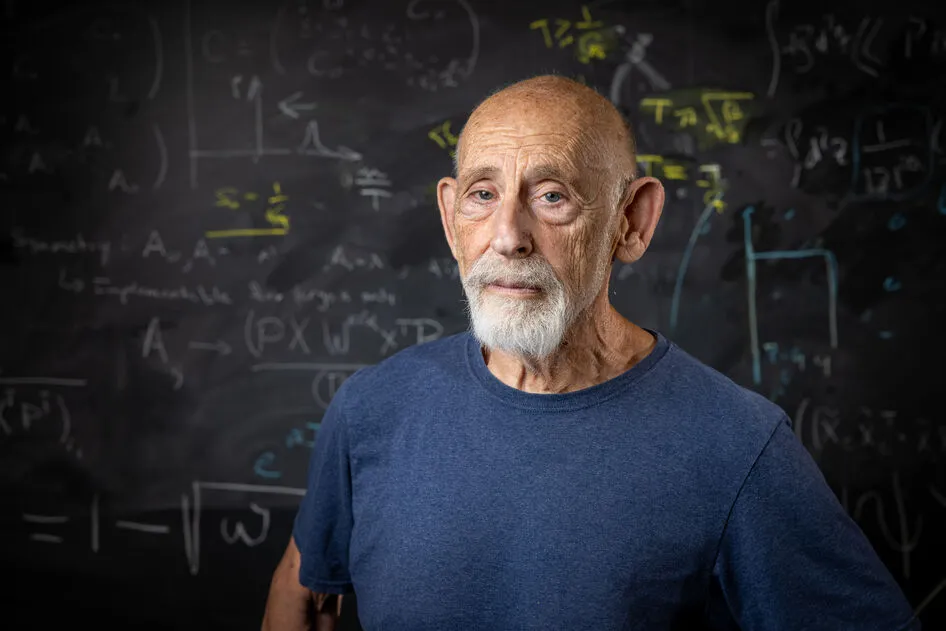Interview with Leonard Susskind, considered one of the fathers of string theory and awarded the Galileo Galilei Medal 2025 by INFN for his fundamental contribution to the challenges that black holes pose to the classical and quantum nature of gravity
Let’s start with the basics: what is string theory?
Today, string theory is thought of as a theory about gravity and the most fundamental things at the smallest possible distances. But it didn’t start that way; it started as a theory of the subnuclear particles, the particles which make up the nucleus: protons, neutrons, and also mesons. Nobody doubted their existence, they were well known experimental objects. What made them interesting was that they were different from electrons. An electron is a point particle, impossible to spin like a football or basketball. A football or basketball, in fact, has some size, and it makes sense to think it rotates around an axis, and as it rotates, it increases its kinetic energy. Now, according to E=mc², Einstein’s famous formula, when energy increases, so does mass. And we knew experimentally that protons and neutrons and mesons were objects that could be spun up, could be vibrated like some kind of elastic object. By hitting every one of these particles, so called hadrons (the particles inside the nucleus), one can cause them to spin and thus increase their mass and energy: a whole family of quantum excited states is produced in this way. It took some time before it was understood that the excited states were behaving like strings, rubber bands being spun up.
Around 1969, myself, Yōichirō Nambu and Holger Nielsen, quite independently, realised that protons and neutrons were behaving very much like elastic strings. We didn’t know why, so we sat down to write a mathematical theory of vibrating elastic strings and what would happen if two of them collided. We thus invented and developed the theory that is now called string theory. It very nicely reproduced what was known about these hadron particles and, in intention, had nothing to do with gravity. It took again some time, a couple of years, for people to realise that this theory of strings contained what was considered a defect at that time: it included particles that were not among the hadrons, massless particles like the photon, but also an object which was behaving very much like a graviton. It was some very bold people, John Schwarz and Joël Scherk on the one hand, and Tamiaki Yoneya on the other, and also myself to a limited extent, who put forward the idea that this could be a theory of gravity. They suggested that it predicted gravitons and that strings were subject to gravitational forces. Just imagine these strings were 19 orders of magnitude smaller than hadrons and all of a sudden you had a theory of gravity.
It evolved over the years into a series of theories with very sophisticated mathematical structures that, frankly, are way beyond me. Through the work of Edward Witten and other people, we arrived at a highly systematic and rigorous theory called supersymmetric string theory. A theory so symmetrical, mathematically perfect, that it does not describe nature, physics, the real world of elementary particles as we know them. Does it have any relation to them? It certainly describes hadrons, but it does not answer fundamental questions about gravity, electrons and the entire Standard Model. After 56 years, we are still struggling to understand the detailed relationship of string theory to elementary particles.
How did you go from describing the behaviour of hadrons, hence the infinitely small, to the vastness of the cosmic landscape[1]?
Trying to answer a separate set of questions. There was indeed a huge puzzle concerning the so-called fine-tuning, and in particular the cosmological constant, or energy of the vacuum. Quantum field theory would attribute an enormously large value to vacuum energy. But at first, most of us did not believe it existed, which is the same as saying that its numerical value was zero. The cosmological constant, however, is not zero, it is very close to zero, but it is not zero, and we had no idea why. It was a mystery. Why was there a cosmological constant? Why was it not zero? And conversely, why wasn’t it that much bigger? Why was it so small? The answers really puzzled me, along with many colleagues.
It was around 1987 that Steven Weinberg proposed the anthropic idea. He imagined a very big universe (which we now call a multiverse) with smaller regions of space, each with a different value of the cosmological constant. He didn’t address why there are so many possible values, but suggested that in our region of space the anthropic idea was at work, namely, that it was governed by constants that allow it to be inhabited by living creatures, people like us or whatever, capable of questioning its nature. It was a goofy and funny idea, which raised another question: if the cosmological constant is small because of the anthropic principle, what would happen if it was bigger? If it was bigger, one would want to be able to argue that life could not exist. Weinberg therefore found a reason why a larger cosmological constant would destroy the possibility of life: it would cause the universe to expand so rapidly that things like galaxies, star structures, would not have been able to form, and if that were the case, life would be impossible. This is the anthropic principle, and Weinberg actually believed it would likely turn out to be wrong. Only one experimental proof could have confirmed it: the measurement of a very small cosmological constant. And a very small cosmological constant is exactly what was found through the next round of experiments. So, all of a sudden, this anthropic idea took on some life as a real possibility, and two other questions emerged: is the universe really much bigger than the part we can see? Can it really contain lots of different environments, a very small fraction of which might be like ours?
The subsequent exploration of the cosmic microwave background did tell us that the universe is much bigger than the portion we can see. Indeed, to agree with observational cosmology, it would have to be at least a factor of 10 in radius bigger than we can see, and that means a factor of thousand in volume. The portion we can see is bounded by a horizon, and it is clear there are things outside the horizon. And this, by the way, is also closely connected to inflationary ideas that the universe inflated so much that it is at least a thousand times bigger than observable, up 10 to the 10 to the 10 to the 10 times bigger.
As for the answer to the second question, the one about many environments including one with a very small cosmological constant, it came from string theory. String theory is in fact not a single thing. You can either say that there are many string theories or, better than that, you can say there are many solutions of the equations of string theory. And those different solutions all have different values of the cosmological constant, different values of the fine structure constant, different kinds of elementary particles. How many solutions are there? Well, some enormous number. It could be 10500 or 101000 or 101000000. Somebody estimated, on the basis of mathematics, that it would be at least 10500 different kinds of environments, 10500 possibilities making up the so-called cosmic landscape.
So, there we were with string theory telling us there are lots of possibilities, observational cosmology telling us that the universe is much bigger than we can see, and this tiny cosmological constant that nobody could explain. When you put these ideas together, what do they say? They say the universe is very big, with many different environments, and we live in the only possible kinds of environment that we could, namely, ones with a small enough cosmological constant for galaxies to form. Is it just a matter of luck? No, life can simply only form in regions which are similar to our own. And that’s where we are now: where, in fact, the best and pretty much only explanation of what we see, as well as of the cosmological constant, is this enormous landscape, the universe filled with different possibilities. A lot of people don’t like this idea, but believe me, they do not have a substitute for it.
Speaking of clashes of ideas, there is one clash that lasted 28 years: The Black Hole War. Can you tell us how you made the world “safe for quantum mechanics”[2]?
Before we get to the clash, let’s go back to the beginning, to 1916, the year Einstein’s theory of general relativity was published. Quickly accepted as the right explanation for gravity, this theory also provided the key to black holes. It was not Einstein who discovered it – he did not believe in black holes and even resisted them – but it was he, within the framework of general relativity, who formulated the equations that would describe them. Their solutions were found shortly afterwards by the astronomer, physicist and mathematician Karl Schwarzschild who, without giving them any particular meaning, just called them “solutions”. Only in time it was understood, partly by Oppenheimer, that stars bigger than a certain size, once out of fuel, would eventually collapse under their own weight and become these Schwarzschild solutions which we now call black holes.
At first there was a lot of confusion. It wasn’t clear that black holes had horizons – it was David Finkelstein who realised it – and it took a whole combination of people (I was not among them) to eventually build the classical theory of black holes. But then, a surprising insight came from Jacob Bekenstein. He realised that black holes had to have entropy, i.e. the information that falls into them remains hidden there, in the form of so many tiny particles that you can’t keep track of. And to this he added that the entropy of a black hole is quantitatively equal to the area of its horizon.
The idea was rejected by Stephen Hawking, who soon had to change his mind. Thinking it over, Hawking added a new piece to the puzzle: he discovered that black holes have thermal properties, they behave as warm objects – they are very, very cold, indeed, but not quite at the zero temperature. And this characteristic, temperature, combined with mass (which black holes have), by the laws of thermodynamics, determines entropy; in other words, Bekenstein was right. Now, again according to the laws of thermodynamics and quantum mechanics, anything that has temperature radiates energy into the vacuum; hence black holes too will eventually evaporate in a very long time.
Having come to this realisation, Hawking publicly posed a crucial question: what happens to the information hidden in a black hole if it eventually disappears? And he also provided an answer as simple as it is controversial: information disappears from our universe, it is lost along with the black hole. A proposal in open violation of the rules of quantum mechanics, which would have led to all sorts of unacceptable thermodynamic facts. He did not do this naively, he knew what it would imply, he simply argued that, taking gravity into account, the laws of quantum mechanics could not be correct.
The world of physics kind of divided into two groups: there were the experts on general relativity, who were convinced that Hawking was right and quantum mechanics would have to be changed, and there were the quantum field theorists and particle physicists, who had no interest in the problem. Only two of us resisted Hawking very strongly: Gerard ‘t Hooft and myself. “This can’t be right”, we kept repeating to everyone; and in my own case, I even made some technical arguments on why it can’t be right, but it pretty much languished. The issue only reopened around 1994, when ‘t Hooft and I introduced a new element: the holographic principle.
The holographic principle is the idea that a region of the world (and the information contained in it) can be described by a theory on the boundary of that region, as if the region was a hologram, a three-dimensional image encoded on a two-dimensional surface. It was greeted as insane. I do remember a colleague sort of jokingly saying to me, “You know, you and ‘t Hooft used to be good physicists, very respected physicists. Now you’ve lost your marbles”. There were, however, a couple of people who took the holographic principle quite seriously: Edward Witten, in particular, kind of almost immediately accepted it, and Juan Maldacena was also very interested in it. And it is to Maldacena, with the discovery of the AdS/CFT (AntideSitter/ConformalFieldTheory) correspondence, that we owe the breakthrough that ended the whole story. He actually investigated a particular example of the holographic principle, the anti-de Sitter space, an infinite region of space (nothing like the real world) in which information is represented as a theory on the boundary. When Maldacena came to this conclusion, at least the string theorists, who were a large portion of the theoretical physics community, immediately accepted the holographic principle, and ‘t Hooft and I were suddenly found to be right. So it became accepted, partly through string theory, partly through the force of the argument itself, that quantum mechanics cannot tolerate information being lost.
To Hawking, your defeated opponent, you gave credit for publicly asking the right question. To date, particle physics is in a sort of impasse, with many competing theoretical models and no candidate strong enough to excel over the others. Are we asking the wrong questions?
Somewhere in the 80s, I began to feel that we would reach this impasse. I suspected it and wondered how we would overcome it. The answer I gave myself was “by thinking about gravity”. Would that help us answer the particle physics questions? I didn’t know. But there were, and still are, questions of gravity and quantum mechanics really unexplored. Someone warned me at the time, reminding me that it would be a million years before I would get any experimental evidence in the direction I was heading to, whereas working on particle physics, on the experiments at CERN, I would get confirmations in a reasonable time. I went on my way, and looking back, I think I made the right decision, I avoided the impasse.
So how do we get out of this? Do you think it will still be theory driving the experiments, as for the Standard Model, or the other way around?
It’s hard to know. It may be that in the next round, when LHC is upgraded to higher energies, something new will be discovered. I can’t imagine how it could take us to the 19 orders of magnitude of the Planck scale where gravitons exist, or to the 17 or 16 orders of magnitude where neutrinos get their mass. We might aspire to another factor of 10, and perhaps discover new particles. It’s very hard to see how that could solve the problems that particle physics faces, how that would lead to any final conclusion. But it is also possible that nothing new will be discovered, that the Standard Model will continue to be highly accurate for as far as we can see. If this experimental limit were to be reached, we would have to proceed from the other end, try to understand the physics of the smallest distances through theory, look at gravity and quantum mechanics.
One last question, a bit about the future of physics and a bit about your skills as a communicator: if you were to write a book today what direction would it take?
Actually, I am already writing a book. There is a series called The Theoretical Minimum[3], and with a co-author, I am working on the cosmology version of that, based on courses I gave at Stanford. They are technical books, intended for advanced undergraduates who study physics, or for those who have enough mathematical knowledge to be able to follow them. But if you mean a book for the general public, like The Black Hole War, that would be too big an undertaking for me at the moment. It took me a year to write The Black Hole War, I had to go on leave of absence, and now I don’t want to take time away from doing physics that I’m very excited by. I don’t rule it out, I would like to in the future, and I think I would try to write a book about the connections between quantum mechanics, gravity and cosmology. The book that I’m not writing would be on the cosmology of the future, which is different from standard cosmology, and on how gravity and quantum mechanics fit together and influence cosmology.
[1] The Cosmic Landscape: String Theory and the Illusion of Intelligent Design is Susskind’s first popular science book, published in 2005.
[2] The Black Hole War: My Battle with Stephen Hawking to Make the World Safe for Quantum Mechanics is Susskind’s second popular science book, published in 2008.
[3] Susskind co-authored a series of companion books to his lecture series The Theoretical Minimum, published between 2013 and 2023.
BIO
Considered one of the fathers of string theory, Leonard Susskind was the first to provide a precise interpretation of the holographic principle and to introduce the idea of the string theory landscape. He is a Professor of Theoretical Physics at Stanford University, founder of the Stanford Institute for Theoretical Physics, and a member of several academies, including the US National Academy of Sciences. He was awarded the J. J. Sakurai Prize in 1998, the Oskar Klein Medal in 2018, the ICTP Dirac Medal in 2023 and the INFN Galileo Galilei Medal in 2025.






